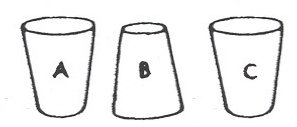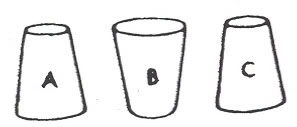Three cups problem facts for kids
The three cups problem is a cool mathematical puzzle. It's also called the three cup challenge. In its most common form, this puzzle is actually impossible to solve!
Imagine you have three cups. At the start, one cup is upside down, and the other two are facing up. Your goal is to make all three cups face up. You have to do this in six moves or less. The tricky part is that in each move, you must turn over exactly two cups.
There is also a version of this puzzle that you can solve. In this easier version, you start with one cup facing up and two cups upside down. To solve it, you just turn over the two cups that are upside down. Then, all three cups will be facing up! A magician might use the solvable version as a trick. They might make it look complicated, then ask someone to try the impossible version.
Contents
Why the Three Cups Problem Can't Be Solved
It might seem strange that a puzzle can be impossible. But for the most common version of the three cups problem, it really is! Let's find out why.
Understanding the Upside-Down Cups
To understand why it's impossible, let's focus on the number of cups that are upside down. We can call this number "W" (for "Wrong way up").
- At the very start of the impossible version, one cup is upside down. So, W = 1.
- Your goal is to make all cups face up. This means you want W to become 0.
- So, you need to change W from 1 to 0. This is a change of -1.
How Each Move Changes the Cups
Remember, in each move, you must turn over exactly two cups. Let's see what happens to W when you turn over two cups:
- Case 1: You turn over one cup that is facing up and one cup that is upside down.
* The cup facing up becomes upside down (W increases by 1). * The cup upside down becomes facing up (W decreases by 1). * The total change to W is +1 and -1, which equals 0. So, W stays the same.
- Case 2: You turn over two cups that are both facing up.
* Both cups become upside down (W increases by 1 for each, so W increases by 2).
- Case 3: You turn over two cups that are both upside down.
* Both cups become facing up (W decreases by 1 for each, so W decreases by 2).
Do you see a pattern? In all these cases, the number of upside-down cups (W) always changes by an even number (0, 2, or -2).
The Proof: Odd vs. Even Numbers
Since W always changes by an even number, let's think about odd and even numbers.
- You start with W = 1 (which is an odd number).
- If you add or subtract an even number from an odd number, the result will always be an odd number.
* Example: 1 + 2 = 3 (odd) * Example: 1 - 2 = -1 (odd) * Example: 1 + 0 = 1 (odd)
This means that no matter how many moves you make, the number of upside-down cups (W) will always stay an odd number. Since you start with 1 upside-down cup, you can only ever have 1 or 3 upside-down cups. You can never reach 0 upside-down cups, because 0 is an even number!
So, because you start with an odd number of upside-down cups (1), and each move changes that number by an even amount, you can never reach zero upside-down cups. That's why the puzzle is impossible to solve!
What if You Start with an Even Number?
This rule about odd and even numbers works for any number of cups.
- If you start with an odd number of upside-down cups, you can never get to zero.
- But if you start with an even number of upside-down cups, you can eventually make them all face up! For example, if you start with two cups upside down, you can just turn them both over in one move.



